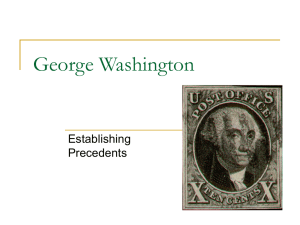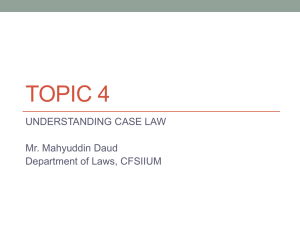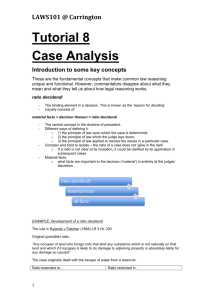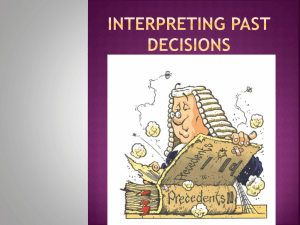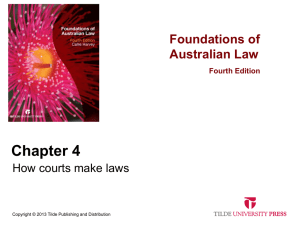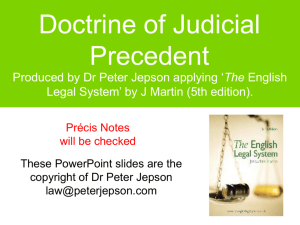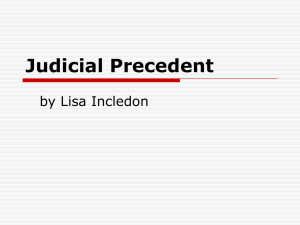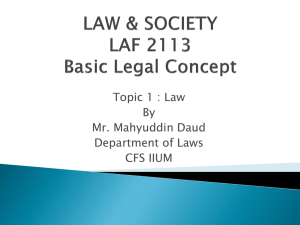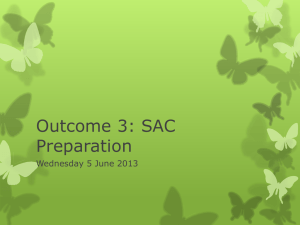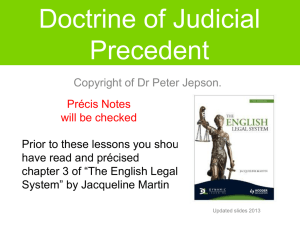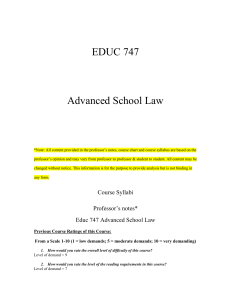End of Unit Work
advertisement
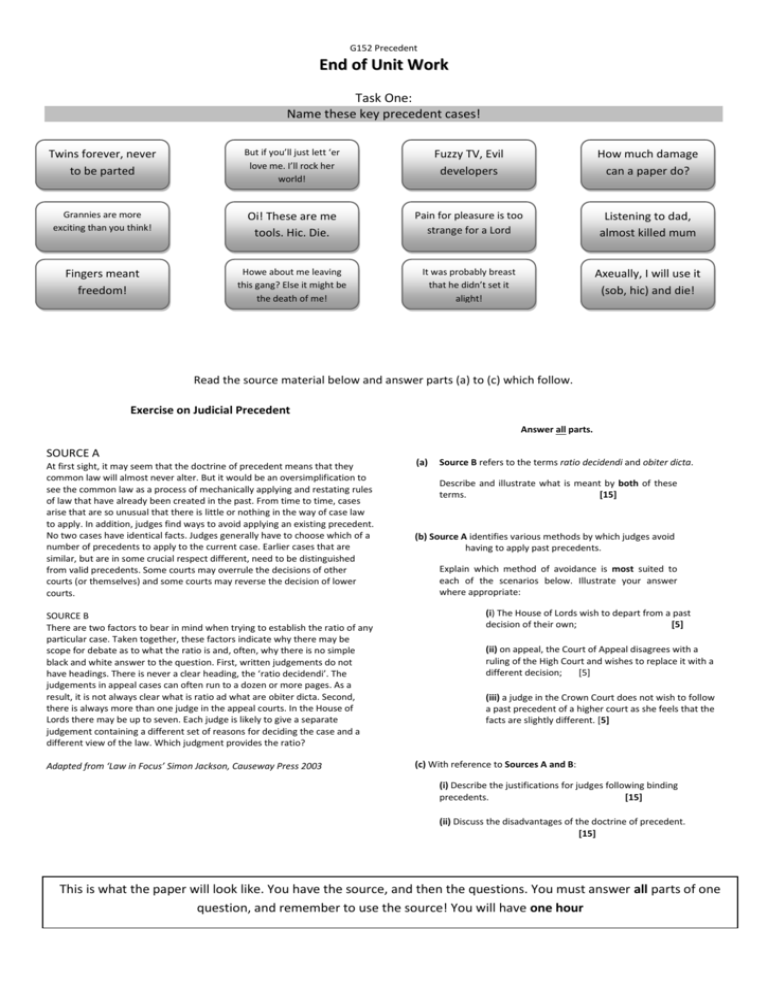
G152 Precedent End of Unit Work Task One: Name these key precedent cases! Twins forever, never to be parted But if you’ll just lett ‘er love me. I’ll rock her world! Fuzzy TV, Evil developers How much damage can a paper do? Grannies are more exciting than you think! Oi! These are me tools. Hic. Die. Pain for pleasure is too strange for a Lord Listening to dad, almost killed mum Fingers meant freedom! Howe about me leaving this gang? Else it might be the death of me! It was probably breast that he didn’t set it alight! Axeually, I will use it (sob, hic) and die! Read the source material below and answer parts (a) to (c) which follow. Exercise on Judicial Precedent Answer all parts. SOURCE A At first sight, it may seem that the doctrine of precedent means that they common law will almost never alter. But it would be an oversimplification to see the common law as a process of mechanically applying and restating rules of law that have already been created in the past. From time to time, cases arise that are so unusual that there is little or nothing in the way of case law to apply. In addition, judges find ways to avoid applying an existing precedent. No two cases have identical facts. Judges generally have to choose which of a number of precedents to apply to the current case. Earlier cases that are similar, but are in some crucial respect different, need to be distinguished from valid precedents. Some courts may overrule the decisions of other courts (or themselves) and some courts may reverse the decision of lower courts. SOURCE B There are two factors to bear in mind when trying to establish the ratio of any particular case. Taken together, these factors indicate why there may be scope for debate as to what the ratio is and, often, why there is no simple black and white answer to the question. First, written judgements do not have headings. There is never a clear heading, the ‘ratio decidendi’. The judgements in appeal cases can often run to a dozen or more pages. As a result, it is not always clear what is ratio ad what are obiter dicta. Second, there is always more than one judge in the appeal courts. In the House of Lords there may be up to seven. Each judge is likely to give a separate judgement containing a different set of reasons for deciding the case and a different view of the law. Which judgment provides the ratio? Adapted from ‘Law in Focus’ Simon Jackson, Causeway Press 2003 (a) Source B refers to the terms ratio decidendi and obiter dicta. Describe and illustrate what is meant by both of these terms. [15] (b) Source A identifies various methods by which judges avoid having to apply past precedents. Explain which method of avoidance is most suited to each of the scenarios below. Illustrate your answer where appropriate: (i) The House of Lords wish to depart from a past decision of their own; [5] (ii) on appeal, the Court of Appeal disagrees with a ruling of the High Court and wishes to replace it with a different decision; [5] (iii) a judge in the Crown Court does not wish to follow a past precedent of a higher court as she feels that the facts are slightly different. [5] (c) With reference to Sources A and B: (i) Describe the justifications for judges following binding precedents. [15] (ii) Discuss the disadvantages of the doctrine of precedent. [15] This is what the paper will look like. You have the source, and then the questions. You must answer all parts of one question, and remember to use the source! You will have one hour The Source: Means: Exercise on Judicial Precedent 5 10 5 10 SOURCE A At first sight, it may seem that the doctrine of precedent means that they common law will almost never alter. But it would be an oversimplification to see the common law as a process of mechanically applying and restating rules of law that have already been created in the past. From time to time, cases arise that are so unusual that there is little or nothing in the way of case law to apply. In addition, judges find ways to avoid applying an existing precedent. No two cases have identical facts. Judges generally have to choose which of a number of precedents to apply to the current case. Earlier cases that are similar, but are in some crucial respect different, need to be distinguished from valid precedents. Some courts may overrule the decisions of other courts (or themselves) and some courts may reverse the decision of lower courts. SOURCE B There are two factors to bear in mind when trying to establish the ratio of any particular case. Taken together, these factors indicate why there may be scope for debate as to what the ratio is and, often, why there is no simple black and white answer to the question. First, written judgements do not have headings. There is never a clear heading, the ‘ratio decidendi’. The judgements in appeal cases can often run to a dozen or more pages. As a result, it is not always clear what is ratio ad what are obiter dicta. Second, there is always more than one judge in the appeal courts. In the House of Lords there may be up to seven. Each judge is likely to give a separate judgement containing a different set of reasons for deciding the case and a different view of the law. Which judgment provides the ratio? Means? Examples: Means? Examples: Means? Examples: Means? Examples: Means? Examples: Means? Examples: Useful information from the source? QUESTION A QUESTION B QUESTION CI QUESTION CII (c) With reference to Source A and B i. Describe the justifications for judges following binding precedents [15] Intro: Main Area/ Point/ Subheading Means Explanation Example or origin LTS? Conclusion ii. Discuss the disadvantages of the doctrine of precedent [15] Introduction Main Conclusion Point Because Illustration/ And However LTS (a) Source B refers to the terms ratio decidendi and obiter dicta. Describe and illustrate what is meant by both those terms. Intro: Main Area/ Point/ Subheading Means Explanation Example or origin LTS? Conclusion (B) Source A identifies various methods by which judges avoid having to apply past precedents. Explain which method of avoidance is most suited to each of the scenarios below. Illustrate your answer where appropriate. i. The House of Lords wish to depart from a past decision of their own. Decision ii. Example/ Evidence AORP On appeal, the Court of Appeal disagrees with a ruling of the High Court and wishes to replace it with a different decision. Decision iii. Why/because Why/because Example/ Evidence AORP A judge in the Crown court does not wish to follow a past precedent of a higher court as she feels that the facts are slightly different Decision Why/because Example/ Evidence AORP
